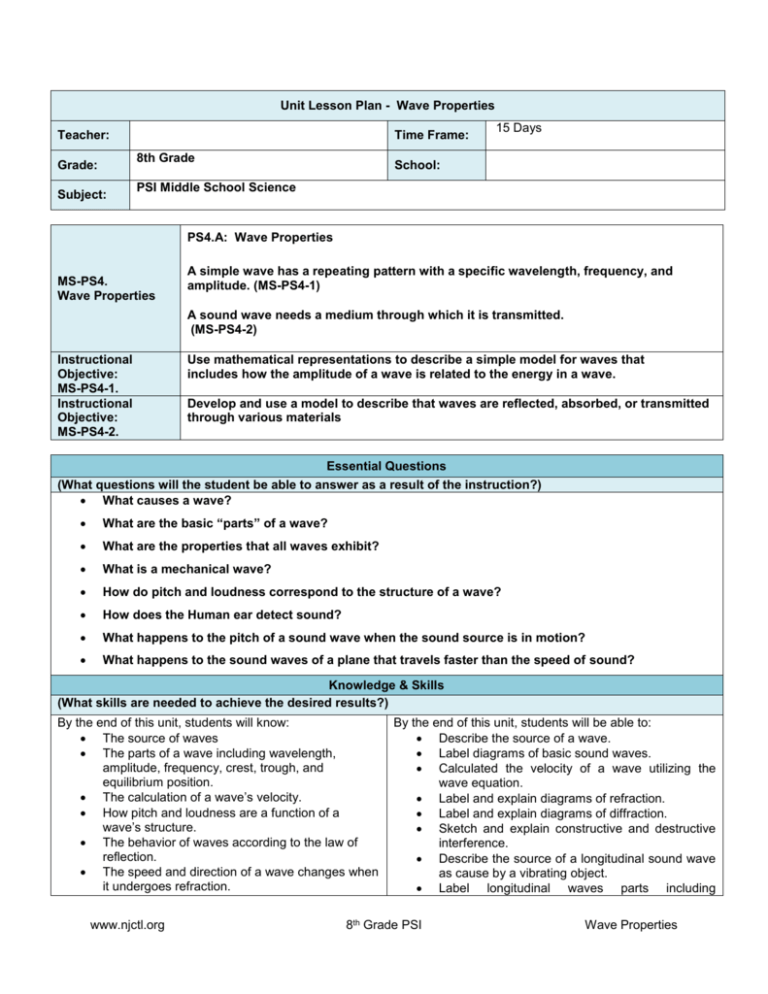Unit Lesson Plan * Atomic Structure
advertisement

Unit Lesson Plan - Wave Properties Teacher: Time Frame: 8th Grade Grade: Subject: 15 Days School: PSI Middle School Science PS4.A: Wave Properties MS-PS4. Wave Properties A simple wave has a repeating pattern with a specific wavelength, frequency, and amplitude. (MS-PS4-1) A sound wave needs a medium through which it is transmitted. (MS-PS4-2) Instructional Objective: MS-PS4-1. Instructional Objective: MS-PS4-2. Use mathematical representations to describe a simple model for waves that includes how the amplitude of a wave is related to the energy in a wave. Develop and use a model to describe that waves are reflected, absorbed, or transmitted through various materials Essential Questions (What questions will the student be able to answer as a result of the instruction?) What causes a wave? What are the basic “parts” of a wave? What are the properties that all waves exhibit? What is a mechanical wave? How do pitch and loudness correspond to the structure of a wave? How does the Human ear detect sound? What happens to the pitch of a sound wave when the sound source is in motion? What happens to the sound waves of a plane that travels faster than the speed of sound? Knowledge & Skills (What skills are needed to achieve the desired results?) By the end of this unit, students will know: The source of waves The parts of a wave including wavelength, amplitude, frequency, crest, trough, and equilibrium position. The calculation of a wave’s velocity. How pitch and loudness are a function of a wave’s structure. The behavior of waves according to the law of reflection. The speed and direction of a wave changes when it undergoes refraction. www.njctl.org By the end of this unit, students will be able to: Describe the source of a wave. Label diagrams of basic sound waves. Calculated the velocity of a wave utilizing the wave equation. Label and explain diagrams of refraction. Label and explain diagrams of diffraction. Sketch and explain constructive and destructive interference. Describe the source of a longitudinal sound wave as cause by a vibrating object. Label longitudinal waves parts including 8th Grade PSI Wave Properties Waves spread out as they pass through an opening during diffraction. Waves can add up to become stronger and cancel each other out during constructive and destructive interference. Sound is caused by a vibrating object and requires a medium to move. Smaller objects produce higher pitched sounds. Loudness is a measure of the amplitude of a wave and is measured in decibels. Sound waves vibrate parts of the ear and the ear sends that information to the brain during hearing. The speed of sound varies in air according to the temperature of the air. The pitch of a sound wave is affected by a sound source in motion and this is called the Doppler Effect. compressions and rarefactions and relate a vibrating object to the source of each part. Relate the frequency of a sound wave to the observed pitch of that wave. Relate the amplitude of a sound wave to the observed loudness of that wave. Describe the basics of hearing and the structure of the outer, middle, and inner ear. Describe how the speed of sound is affected on warmer and cooler days. Describe the observed pitch that originates from a moving sound source. Describe the arrangement of sound waves produced when a sound source is moving faster than the speed of sound. Assessment (What is acceptable evidence to show desired results (rubrics, exam, etc.)? During the Smart Notebook lesson designed to introduce concepts, students will be continually questioned on these concepts using a combination of class work/homework questions and the SMART Response system. Classwork and Homework questions will be discussed as a class and misconceptions will be addressed by the teacher prior to the formal evaluations listed below. Quiz 1: What is a wave Lab 1: Slinky Lab Lab 2: Wave Equation Lab Quiz 2: Parts of a wave/Wave equation Activity 1: Wave Properties Activity Quiz 3: Properties of Waves Lab 2: Tuning Fork Lab Quiz 4: Sound Simulation 1: The Doppler Effect Test – Wave Properties (What is the sequence of activities, learning experiences, etc., that will lead to desired results (the plan)? Day 1 2 www.njctl.org Topic Classwork Homework What are waves? Slides 2-22; Questions #1-6 Questions #7-11 Study for Quiz Quiz #1- What is a Wave?; Slinky Lab Finish Slinky lab What are waves? 8th Grade PSI Wave Properties 3 Parts of a wave Slides 23-47; Questions #12-17 Questions #18-22 4 The Wave Equation Slides 48-56; Questions #23-28 Questions #29-33 5 The Wave Equation Wave Equation Lab Finish Lab questions; Study for Quiz; 6 7 Properties of waves Properties of waves Quiz #2- Parts of Wave/Wave Equation; Slides 57-77; Questions #34-39 Slides 78-85; Question #40; Wave Properties Activity Quiz #3- Properties of Waves; Slides 86-96; Questions #46-50 Questions #41-43 Questions #44-45; Study for Quiz 8 Sound as a Wave 9 Sound as a Mechanical Wave Slides 97-109; Questions #56-60 Questions #61-65 10 Properties of Sound waves Slides 110-120; Questions #66-70 Questions #71-74 11 Sound Waves Lab Sound Waves Lab Finish Tuning Forks Lab Sheet 12 The Doppler Effect Slides 121-144; Questions #75-79 Questions #80-84 13 The Doppler Effect Simulation 14 MC Review for Test & Review Study Guide 15 Unit Test Quiz #4- Sound; Doppler Effect Simulation MC response lesson & review Free response from Study Guide Testing & Wave Properties Test Questions #51-55 Finish Doppler Effect Simulation & Study Guide STUDY N/A *While there are many slides for each topic, several slides within the notebook are hidden and won’t be used during instructional time. **HW Problems are currently not scaffolded from least to most difficult, but are instead listed in order of topic. Teacher should pay special attention at the end of each class period when assigning HW so that only problems related to the topic that was taught are being assigned. www.njctl.org 8th Grade PSI Wave Properties






